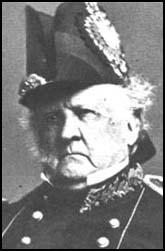Winfield Scott

Winfield Scott was born in Petersburg, Virginia on 13th June, 1786. Scott joined the army in 1808 and served with distinction as a young brigadier general in the 1812 War. Captured on the Niagara frontier he was exchanged in 1813 and fought with distinction at Chippewa (5th July, 1814) and Lundy's Lane (25th July, 1814).
After the war Scott attained the rank of major general and went to Europe to study military tactics and in 1841 became commanding general of the United States Army.
At the start of the Mexican War Scott recommended to President James Polk that General Zachary Taylor should command United States forces in the field. However, after Taylor made slow progress, Scott made a seaborne invasion of Mexico that captured Vera Cruz and a march inland to Mexico City, which was captured on 14th September, 1846. Meanwhile General Stephen Kearny conquered New Mexico and with the support of John Fremont took control of California.
A member of the Whig Party, Scott was nominated as its candidate in the 1852 presidential election. The party was badly divided with Southeners deeply suspicious of Scott's views on slavery. In the election Franklin Pierce won 1,601,474 votes against Scott's 1,386,578.
On the outbreak of the American Civil War, President Abraham Lincoln called a special session of Congress and proclaimed a blockade of Gulf of Mexico ports. This strategy was based on the Anaconda Plan that had been developed by Scott. It involved the army occupying the line of the Mississippi and blockading Confederate ports. Scott believed if this was done successfully the South would negotiate a peace deal. However, at the start of the war, the US Navy had only a small number of ships and was in no position to guard all 3,000 miles of Southern coast.
Scott was considered too old at seventy-five to command the Union Army and in November, 1861, retired from office. Winfield Scott died at West Point on 29th May, 1866.

